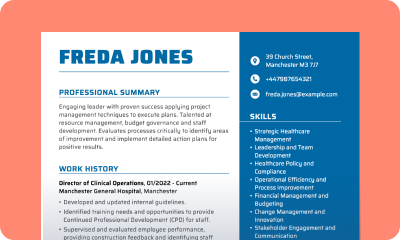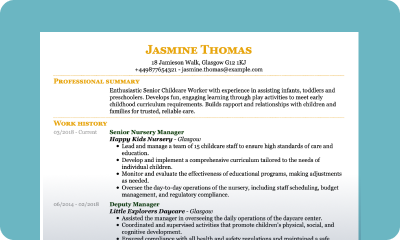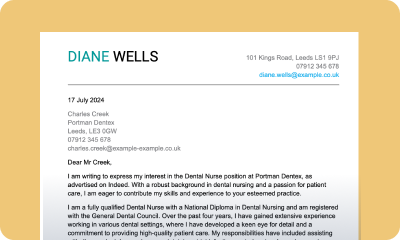From the standardised Europass format to more tailored European CV layouts, this guide will walk you through everything you need to know to write a European CV that lands jobs in every European country.
Whether you’re applying in Germany, Spain, France, or beyond, you’ll learn how to create a European-style CV that’s clear, compelling, and designed to make a strong first impression.
SEARCH ALL CV EXAMPLES
What is the best format for a European CV?
Most European candidates choose between two main formats: the chronological CV and the skill-based (functional) CV. As to which CV format you should choose, let’s discuss these two options:
1. Chronological CV
The chronological CV is the most widely used format across Europe. It lists your work experience in reverse order, starting with your most recent role and working backwards.
It’s best for candidates with a steady career history. This European CV format is easy for recruiters to scan, clearly shows career progression, and works well with Applicant Tracking Systems (ATS).
2. Skill-based CV
A skill-based CV focuses on your abilities rather than your job titles. Instead of listing each role chronologically, you group your experience under skills or competencies, such as “Project Management” or “Customer Relations.”
This European CV format is best for career changers and candidates with gaps in their work history. This CV style emphasises what you can do rather than when you did it and helps de-emphasise less relevant roles.
General European CV formatting rules
Length
- Aim for a two-page CV in most cases. A one-page CV is fine for entry-level candidates, and three pages are a good choice only for senior professionals.
Font and size
- Use clean, professional CV fonts such as Arial, Calibri, or Times New Roman.
- Keep font size between 10–12 pt for body text; 14–16 pt for headings.
Margins and spacing
- Set standard 2–2.5 cm margins.
- Keep spacing consistent between sections to improve readability.
Headings
- Use clear, descriptive headings (e.g., Work Experience, Education, Skills).
- Bold or slightly increase the size of section titles to guide the reader’s eye.
Bullet points
- Use concise bullet points for responsibilities and achievements.
- Start with action verbs (e.g., Managed, Developed, Implemented).
Colours and graphics
- Keep colour use minimal—subtle accents are fine, but content should remain the focus.
- Avoid graphics or overly creative layouts.
ATS compatibility
- Save as a PDF unless the job ad requests another format.
- Avoid text boxes, columns, and images for critical content to ensure it passes ATS scans.
How to write a European CV
There is no single “one-size-fits-all” European CV. When writing a European CV, you need to understand the core principles: clear structure, relevant content, cultural awareness, and then adapt them to your target country, industry, and role.
Here’s how to write a European CV step-by-step:
1. Start with personal information
In Europe, what counts as “standard” personal info varies by country. Include too little and you risk looking incomplete. Include too much and you may raise eyebrows, or even run into discrimination issues in more privacy-conscious markets.
The core essentials on a European CV are:
- Full name – Use your full professional name, matching your official documents.
- Phone number – Include the country code if you’re applying outside your home country (+44 for UK, +49 for Germany, etc.).
- Email address – Use a professional email, ideally based on your name. Avoid casual addresses (no nicknames or numbers from your teenage years).
- City & country – Full street addresses are optional. For international applications, the city and country are usually enough.
- LinkedIn profile – Highly recommended if it’s up to date and aligned with your CV.
- Additional links – Links to your professional website or portfolio are vital across most jobs in the creative industries.
In some European countries, employers are still accustomed to seeing more personal details. These may include:
- Nationality
- Photo
- Date of birth
Only include these if they’re normal in your target market! Do your research on the country you’ll be applying to.
2. Craft a strong professional profile
When it comes to the standardised Europass CV format, which you can find on the official Europass website, it has no space for a personal profile. This is one of the main points of difference between a Europass CV and the classic British CV. Put simply, the Europass CV format does not include a personal statement.
However, if you’re making a custom European CV, you still can (and should) lead with a professional statement that’s short, targeted, and outcome-focused. It should include:
- Job title or specialisation – e.g., “Digital Marketing Specialist with 6 years’ experience…”.
- Key skills and industry focus – e.g., “Specialising in B2B campaigns, content strategy, and analytics”.
- A standout accomplishment or measurable result – e.g., “Improved document processing times by 12%”.
- How you can benefit this employer – e.g., “Help the company grow its reach through data-driven campaigns”.
For example:
Bilingual Sales Manager with 8 years’ experience in SaaS and fintech, delivering consistent double-digit revenue growth across European markets. Successfully led and developed sales teams that increased annual revenue by 35% and built lasting client relationships. Ready to bring strategic sales leadership and market expansion expertise to drive growth for HorizonTech Solutions.
3. Highlight your work experience
This is the heart of your European CV. It’s where employers decide whether you’re worth shortlisting, so every word here needs to work hard.
A strong work experience section has to prove your impact. Recruiters aren’t only looking for what you did; they want to know how well you did it, and how it’s relevant to their role.
List roles in reverse chronological order (most recent first) and include:
- Job title – Use the official title, but adapt it slightly if needed for clarity across languages or markets (e.g., “Account Manager (B2B Sales)”).
- Company name & location – Include the city and country; international employers appreciate context.
- Dates of employment – Month and year (e.g., Jan 2020 – Jun 2023).
- Achievements & responsibilities – Start with achievements, then add key duties.
And to write the best, most impactful bullet points, follow these steps:
- Lead with strong action verbs: “Developed,” “Delivered,” “Increased,” “Reduced”
- Quantify results where possible: “Increased sales by 22% in one year” carries more weight than “Responsible for sales growth”
- Focus on relevance: Highlight skills and results that align with the target role
For example:
Sales Manager
HorizonTech Solutions, London, UK
March 2021 – July 2025
- Increased annual revenue by 35% within two years through strategic market expansion and targeted sales campaigns.
- Led a team of 10 account executives, achieving 120% of collective sales targets for three consecutive years.
- Expanded client portfolio by 45%, securing long-term contracts with multinational corporations across Europe.
- Implemented a new CRM strategy, improving lead conversion rates by 25% and reducing response time to client enquiries by 40%.
- Delivered monthly training sessions to enhance team negotiation skills, resulting in a measurable uplift in customer satisfaction scores.
4. Present your education
Employers want to see what you studied, where you studied, and whether your qualifications match their standards.
For recent graduates, the CV education section often takes priority over work experience. For mid- and late-career professionals, it serves to back up your expertise and establish your technical or professional grounding.
List in reverse chronological order (most recent first) and include:
- Degree or qualification title – Use the full title (e.g., “Master of Science in Mechanical Engineering”).
- Institution Name & Country – Include the city and country for international clarity.
- Dates attended – Month and year (optional for older qualifications).
- Specialisations or key modules – Only if they are directly relevant to the role.
- Thesis/dissertation title – For research-heavy roles or academic positions.
For example:
Master of Business Administration (MBA)
ESADE Business School, Barcelona, Spain | 2019 – 2020
- Specialisation in Strategic Management and Innovation
- Final project: Developed market entry strategy for a fintech start-up
5. List valuable skills
Your European CV skills section is where you give employers a quick, at-a-glance view of what you can do. It’s one of the most important areas for making sure you have an ATS-friendly CV.
In the European job market, a well-organised skills section can also help bridge cultural or language gaps. Recruiters may skim your work history, but they’ll almost always scan for core skills to see if you match the job profile.
When it comes to skills, there are two main categories:
- Hard skills – Specific, measurable abilities or technical knowledge (e.g., “Java programming,” “SEO strategy,” “Data analysis”).
- Soft skills – Interpersonal or organisational abilities (e.g., “Team leadership,” “Cross-cultural communication,” “Negotiation”).
A sample European CV skill list could look like:
- Strategic sales planning
- Team leadership
- Client relationship management
- Negotiation and persuasion
- Data-driven decision-making
- Market analysis and forecasting
- Communication skills
- CRM software proficiency (e.g., Salesforce, HubSpot)
- Problem-solving under pressure
- Contract management
6. Improve your European CV with bonus sections
Not every application needs these, but the right extra sections can add depth and credibility to your European CV.
Include 1–3 sections of your choice. Keep them brief. Around two to four bullet points per category is enough. You want to add value without distracting from your main qualifications and experience.
- Certifications – Highlight relevant professional credentials or industry-specific qualifications that add credibility to your expertise.
- Languages – Showcase your multilingual abilities, including proficiency levels using the CEFR scale for clarity.
- Volunteer experience – Demonstrate community engagement and transferable skills gained outside of paid employment.
- Publications – List articles, research papers, or books that establish your authority in your field.
- Awards and honours – Include professional or academic achievements that set you apart from other candidates.
- Conferences and workshops – Show your commitment to continuous learning by listing relevant events you’ve attended or spoken at.
- Projects – Detail notable professional or personal projects that demonstrate your skills in action.
- Professional memberships – Mention your involvement in industry associations or networks to highlight your professional engagement.
- Hobbies & interests – Add hobbies that are relevant to the role or that reveal valuable soft skills, such as leadership or creativity.
For example:
Certifications
- Certified Sales Leadership Professional (CSLP), Association of Professional Sales — June 2022
- HubSpot Inbound Sales Certification — September 2021
Languages
- English – Native
- Spanish – Bilingual
- German – Intermediate (CEFR B1)
Publications
- “Driving Growth Through Data-Driven Sales Strategies,” Sales Excellence Journal — March 2022
- “Building High-Performing International Sales Teams,” keynote article, European Business Review — October 2021
European CV format samples
Sometimes it’s easier to see things put into practice. To give you a better idea of how to write your CV, we’ve listed a few European CV samples.
We understand that not everyone has the same background, which is why our CV examples cover a range of experience levels.
Sample 1 – Professional European CV
This European CV template is an ideal starting point for a wide array of candidates. It provides the ideal layout for a substantial amount of experience in multiple roles. Simple subheadings keep everything well organized and allow recruiters to easily skim-read.
Sample 2 – European CV format for students
The European student CV format puts education first and emphasizes the candidate’s academic background. It’s followed by plenty of transferable skills and duties from their work experience.
Sample 3 – Experienced European CV
As an experienced candidate, it’s best to use a European CV layout that’s clear and simple. That way, you can fit in various skills, responsibilities, and qualifications without overwhelming recruiters. You can use fewer responsibilities to describe each role if you want to delve deeper into your work history.
Dos and don’ts for a European CV
When you’re using the European style CV, the guidelines can vary quite a bit depending on what kind of role you’re applying for. However, there are a few universal rules that apply across the board:
Align your skills, achievements, and keywords with the specific job description and the country’s expectations.
Use measurable results and active verbs to show impact—employers want proof, not just responsibilities.
Adapt your format, photo use, and level of detail to the conventions of the country where you’re applying.
Use clear headings, bullet points, and standard fonts so both humans and applicant tracking systems can read it easily.
Focus on the most relevant 10–15 years of experience—quality over quantity.
Skip details like marital status or full address unless required in that country.
Avoid clichés like “team player” without evidence—always back up skills with examples.
Typos, grammar mistakes, or inconsistent formatting can cost you the interview before you even start.
Frequently asked questions about the European CV format
Is the Europass CV the only accepted CV format in Europe?
No. The Europass CV is not the only option. Many European employers prefer a customised CV that follows local norms for layout, length, and content. Use Europass if you’re applying to multiple countries or formal, public-sector roles, but for private-sector jobs, adapting your CV to the specific market often works much better.
How long should a European CV be?
Most European CVs are two pages long. Senior professionals with decades of work experience can stretch to three pages, while entry-level candidates can stick to one. Include enough detail to show your value, but avoid padding with unrelated or outdated information.
Should I include a photo on my European CV?
It depends on the country. In Germany, France, Spain, and several other European countries, a professional photo is still common. In the UK, Ireland, and the Netherlands, photos are generally avoided to prevent bias. Always check local conventions before adding one.
Should I translate my CV for different European countries?
Yes. If the job posting is in another language, your CV should be too. Employers value candidates who show cultural and linguistic awareness. However, don’t rely solely on machine translation. Have a native speaker or professional translator review it to avoid errors that could harm your credibility.
Are cover letters still necessary in Europe?
In most countries, yes. While some employers make them optional, a tailored cover letter can greatly improve your chances by explaining why you’re a strong match for the role. In countries like Germany and France, cover letters are often expected.
Should I include references in my European CV?
Not unless the employer specifically asks for them. It’s more common to simply omit adding references. This keeps your CV concise and protects the privacy of your referees until the employer asks you to provide them.
How do Applicant Tracking Systems (ATS) affect European CVs?
Many large employers use ATS software to filter applications before a human sees them. To get past these systems, keep your CV formatting simple. Use standard headings, avoid graphics in key sections, and include CV keywords from the job description naturally in your work history and skills sections.
Build your perfect European CV format in 3 easy steps
- Choose a professionally designer CV format
- Add expertly written, tried-and-tested phrases
- Download your CV and apply!



